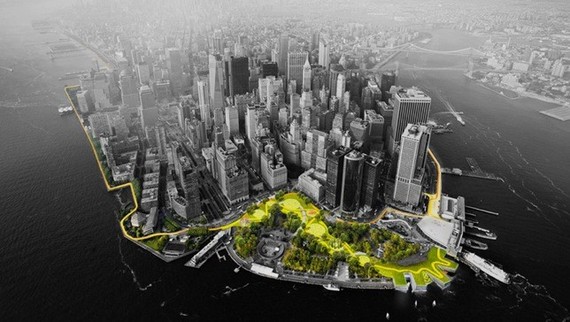The planning for the impact of the next 100 year storm on the East Coast in the aftermath of Sandy took another giant step forward on April 3 with the unveiling of the final proposals of ten design teams. It took place at a reception on an un-partitioned, unfurnished skyscraper floor in lower Manhattan with a spectacular three -sided view of the vulnerable New York City Harbor. The process of promoting resilience--Rebuild By Design--has been guided by the Institute for Public Knowledge at NYU, which made certain that ALL the stake holders--government entities, elected officials, issue-based organizations and community groups had a say in the specifics of each design. The results are breathtaking.
The biggest threat from such storms is flooding from the storm surge. The simplest protection is some kind of barrier. But people don't want to live with a barrier that is ugly, cuts off access to the water when there is no storm (which is most of the time) and is useful only as a barrier with no redeeming aesthetic or recreational uses. The reality is that we don't want barriers that imprison us and that anything less will not stop flooding from happening. The new idea is to plan for ways to recover quickly when flooding occurs and make sustainability a design challenge.
Each team took an interdisciplinary approach to the individual problems of various geographical locations--lower Manhattan, the South Shore of Long Island, the Jersey Shore, the Meadowlands and more. The team makeups included water and urban planners, landscape architects, engineers, real estate and economic developers, plus a healthy contribution of Dutch expertise. (The people from the Netherlands have 1000 year history of reclaiming underwater land by systems of drainage canals, dikes, and pumps. They are currently planning for a rise in sea level of one meter in the next eighty years.)
One big idea behind all the specific proposals is to work with nature, not fight it. Natural barriers, like marshlands and barrier islands are replenished by the sediment from a storm surge. Why not build the structures that allow flooding to rebuild wetlands as recreational areas? Why not build barrier islands ten miles off the Jersey shore that factor in coastal processes and deflect storm surges? Why not also use the wind on these barrier islands to generate electricity? How about using Staten Island's exposure to the ocean to create a living breakwater called the Billion Oyster Project?
And what about Manhattan? How can we protect 10 continuous miles of low-lying geography of an intensely vibrant and vulnerable urban area? How about using this opportunity to create urban farms and East River swimming holes?
I was once asked to define "innovation." Here's what I came up with:
Innovation is the creation of something new by using disparate existing elements in novel ways to fill a contemporary need while forecasting its own future growth and development.
HUD Secretary, Shaun Donovan, and Rockefeller Foundation President, Dr. Judith Rodin, spoke of their support for this work. Secretary Donovan said,
"Climate change is presenting unprecedented threats to communities across the country. Rebuild By Design is a model for how we can use public-private partnerships to spur innovation, protect our communities from the effects of climate change, and inspire action in cities across the world."
Although it will cost billions to build, the cost of doing nothing is far greater. I feel optimistic about the future of the planet when I see what these amazing teams have challenged us to build.

